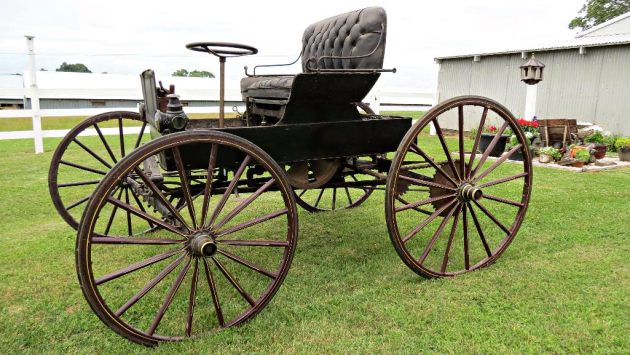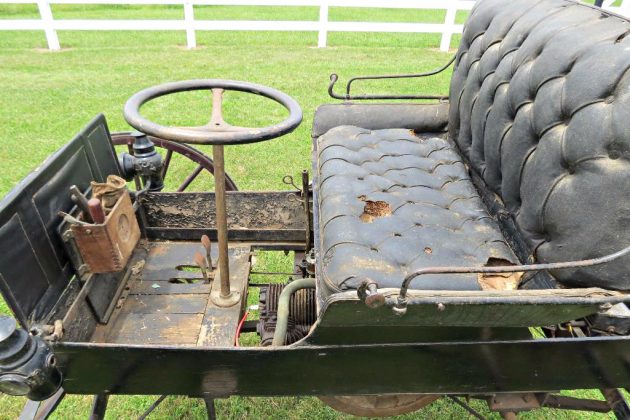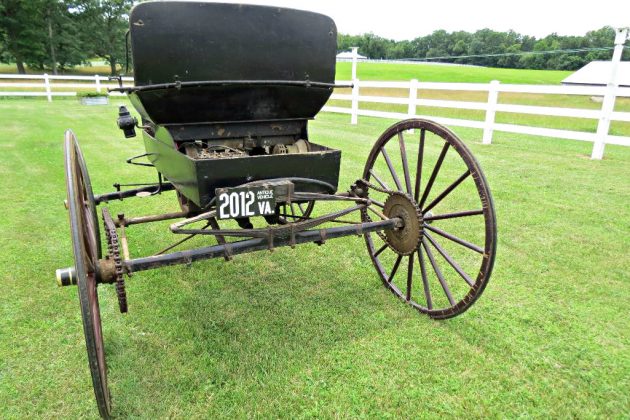In the early days of the automobile there were so very many tinkerers that developed their own version of the automobile leading to many small automotive brands in the early days. This 1907 Success Auto Buggy Model C spent its entire life in the same area it was purchased new, and spent many years tucked away under a canvas tarp in a barn. Thankfully the dry barn preserved this early beauty to be discovered in such a nice original condition. With 9 days remaining to bid, this Success is currently bid up to $7,050. Check it out here on Enlisted Auctions out of Stuarts Draft, Virginia.
The opposing air cooled two cylinder engine can be turned over and does have compression. The auction house is leery of awakening such an old engine, but from the details, this engine sounds promising. There are a few “new” wires to be seen on this car, but a couple of them appear to be battery terminal related. The drive-train appears very complete, which is wonderful as I would imagine that Success parts are nearly non-existent. The wooden spoke wheels look excellent, as do the hard tires.
The interior as you would imagine is quite simple, and still strongly resembles a horse buggy. The horse hair filled seat is still mostly there and in arguably good condition for being 110 years old. The air cooled engine could pull cool air from the cabin, or better yet on chilly days it also functioned as a foot heater. The steering on this Success is rather unique as the front steering is set up as a “fifth wheel” pivoting from the center of the front axle like many horse drawn buggies. Owning and driving a car in this era absolutely required tools, and patience to make your trip a “Success-ful” one. The Victorian era folks were not shy to name their products to inspire potential buyers. Many of these early buggies inspired, or infuriated, later successful automotive pioneers like the Packard brothers who purchased a Winton Motor carriage that was so unreliable and bad according to their account, that they developed their own automobile that would later be known as Packard.
With a simple body construction this not so weather friendly Auto Buggy has survived the test of time nicely. There are a few areas on the wooden body parts that have chipping paint, including the wooden wheels. The seller has mentioned that some touch up work has been done, so this one isn’t “exactly” original, but darn close. The fold up buggy roof is included, but is very delicate and needs to either be carefully stored, or restored and used. Although not particularly fast, this Success Auto Buggy is just as important as any classic, perhaps even more so. Certainly a rare sight to see and even a rarer opportunity to own, this important and well maintained Auto Buggy is a valuable piece of our automotive history. Would you take on this rare and important piece of automotive history?





Wow! I love this! Quite the success!
6 years to late to be Victorian which era was 1837 to 1901 you mean late edwardian ….
One of the carriage museums I bought had a similar Duryea motor carriage. It was very simple and ran great after sitting since before the war. We rebuilt the wheels, put new rubber on them and drove it. It did have tiller steering instead so a wheel like this one. It was worth surprisingly little money.
No air our power brakes, no power steering no hi fi stereo
It isn’t safe either……..no dual master cylinder, air bags, 5 mph bumpers……everyone that has ever driven it will die………….
Maybe even everyone who has driven it is now Dead? Definitely unsafe going by that thinking! 😉
This is about as basic as a car gets.
I hope the auction is successful.
It looks like they used some Ford parts to build it.The coils and coil box appear to be Model T.But why 4 coils for a twin cylinder engine? Spares ?
Awesome find.
is that… is that a centrifugal siren on the upper right hand corner of the motor picture?
See kiddies, your great, great grandfather was rockin’ big rims before it was cool. Now that’s old, old, OLD school!
I’d love to see this in person! How does it start? Electric starters were a long way of in 1907. There is no differential, how does it go around corners? The wheels certainly didn’t have rubber tires in 1907. And the gearing seems way too high through those big wheels to have any torque for going up hills. What do you do for BRAKES, there are no friction pads on the wheels ? Is the siren for parades? I wonder if the front axle still has the hangers for the shafts so that when it broke you could install the shafts and use a horse to bring you home. Really neat find. I have restored several horse buggies, one of them looks just like this but for horses. This one would be a very fun project and it is at a great price right now.
I found more photos and now see the hand crank on the right hand side. Could there possibly be a band brake off of the transmission? Is it possible that the large hubs have some sort of ratchet mechanism to allow for differential axle speeds? The single wood frame shaft in the center of the buggy is clearly undersized for this motorized conversion and appears to have been has been modified (cladded) with steel several times. You would need to be very careful not to turn too sharp as there is nothing to stop the body from climbing up on the rubber tire and flipping the buggy. It would not be easy to steer this through the fifth wheel, normally you would have the leverage of the 5 foot long shafts. It is so quirky and unique, I really like this and I wish it were closer to me.
If you take a look at the history books you’ll see that many early cars where built from carriages. David Buick only built 36 or 37 cars before going to work for a carriage company to continue production.
Rubber tires were around 60 years before cars. The rubber was installed on channel steel and cut from rolls with hammer forged wire to keep it on. The high end carriages all had them. The engine provides the brake, no differential. The speeds were slow and they are not difficult to control. Just like a non cut under carriage, it will have stops to prevent turning the wheels into the body, many old carriages have marks on the body where wheels cut them. My Dureya didn’t have a transmission. Some of these were driven by leather belts instead of chains. They used a lever with a wheel to tighten the belt making it go. There was a lot of steel (iron) reinforcement on carriages starting very early. Cut under carriages all had strong steel reinforcement to keep structural integrity. The give away on metal in carriages is welding or brazing, the originals were all hammer forged or cast parts. No welding until later when industrial electricity became available. My 1905 all iron 100 foot tug boat is all riveted and forged.
There is no way to make a structure like this work without a lot of iron. This is a Brewster carriage from the 1860’s rubber tires and all.
And everything in the wooden toolbox up front it’s all you will ever need to fix it
Ur-donk.
Actually, maybe not as far from the electric starter as it might seem. Cadillac introduced it in 1911 or ’12.
External coil packs. Where have I seen those before? Everything old is new again, as they say.
Interesting and beautiful car. If I had a huge building…
I live 20 miles from this thing I’ve seen it posted on the harrisonburg craigslist
Quite possibly the coolest car I’ve ever seen
One way to say you bought your “Success”……….
What a cool ride, and more than likely, easily converted to true 1 horsepower, if needed.
I’d think about adding a period correct 1907 Savage pistol to stave off potential road rage outbreaks while driving 20mph to the cars and coffee gathering. :)
I highly doubt it was originally built with a steering wheel.
This brand is only shown with a steering wheel in old photos. Some brands had either a tiller or wheel depending on the model. The first cars, (Mercedes) were tiller steer.
Dave;
To continue with your history lesson; Packard is credited with the first production steering wheel on an automobile in 1900. In Europe a couple of “racing” cars were outfitted with crude steering wheels in the late 1890s, but Packard was the first to install what we know today as the basic steering linkage and gear box.
Gotta love a Packard…………
Ahhh…posi traction….(that’s all I got) LOL
Seems pretty dated for 1907, a pretty good price though for a car 110 years old.
yard art
What a great old gal!! I’ve been looking for a 1907-12 for our historical society. There were Brushes, Holsmans, Internationals, Olds, Sears, Wintons, etc.in this low price high-wheeler class. Heard of the Success, but never saw one. Its got to be rare. It is amazing how similar these cars were. Most of the engines were made by Reeves. These all had “atmospheric” intake valves with real exhaust valves. Without magnetos you stopped when you ran out of gas or battery!! Without ackerman steering linkage this has to be tippy, but it has a wheel!! Two transverse springs (rather than 4 longitudinals) will give your neck a workout. These sell for $10-20k depending on condition, except the Olds which can reach $90k. I see 2 foot pedals on this but can’t find the clutch, is it in the big drive gear? I think the differential is slipping dirt.
I bought a Sears last week in Milwaukie it has two one way clutches for a diff.
Wow… sold for a hair over $20,000…